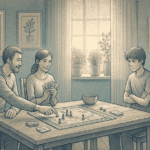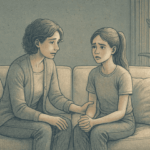What Is Bathroom Camping?: Teen Coping Mechanisms for Mental Health Issues

The bathroom has always been a kind of retreat for many people. Maybe we keep magazines and books in it, or simply scroll through social media while there to give us a bit of rest and reprieve. A growing number of teens are now engaging in a similar behavior, and it has become known on social media as “bathroom camping.”
So, what is bathroom camping, really? And is it a form of beneficial self-care, or damaging to mental health? This article can help caregivers understand the reasons behind bathroom camping by covering:
- What bathroom camping is and why teens are doing it
- What parents and caregivers can do to support teen mental health
- How therapy can improve teen mental health issues
- Answers to frequently asked questions about bathroom camping

What Is Bathroom Camping and Why Are Teens Doing It?
Bathroom camping is a behavior where teens retreat to the bathroom as a way to cope with overwhelming feelings. It isn’t so much about using the toilet as it is about using it as an escape from stressors. Unlike a quick break, bathroom camping can last anywhere from 10 minutes to an hour.
Teens who engage in bathroom camping may sit quietly scrolling through their phones, listening to music, or simply shutting down, allowing them to unwind emotionally. Some report feeling overwhelmed by anxiety or the need to reset when things become overstimulating. Others may use it as a way to avoid triggering social situations or academic pressures.
In other words, the bathroom can act as a space that gives teens a few minutes of solitude and a place to breathe; somewhere where they can get a break from the daily pressures of life.
Bathroom camping is a behavior where teens retreat to the bathroom as a way to cope with overwhelming feelings. It isn’t so much about using the toilet as it is about using it as an escape from stressors. Unlike a quick break, bathroom camping can last anywhere from 10 minutes to an hour.
Teens who engage in bathroom camping may sit quietly scrolling through their phones, listening to music, or simply shutting down, allowing them to unwind emotionally. Some report feeling overwhelmed by anxiety or the need to reset when things become overstimulating. Others may use it as a way to avoid triggering social situations or academic pressures.
In other words, the bathroom can act as a space that gives teens a few minutes of solitude and a place to breathe; somewhere where they can get a break from the daily pressures of life.
Is Bathroom Camping A Healthy Coping Strategy?
Whether bathroom camping is a healthy coping strategy or not may depend on the reasoning behind it and how often it occurs. Are teens using it as a quiet place to take a deep breath and reset? Or are they avoiding emotions or difficult situations? Is the amount of time they’re spending in there affecting school, relationships, or other areas of their lives?
The answers to these questions could determine whether bathroom camping is a healthy coping strategy or not.
The behavior may seem harmless, as it’s offering some teens a place of peace in a world that often feels overwhelming. However, there are some concerns about it being a sign of deeper emotional distress, like anxiety, depression, trauma, or bullying, that deserve attention.
Bullying and bathroom avoidance may be particularly linked, as students may hide to escape harassment or peer aggression. So, how can you know whether bathroom camping is a form of mental health support for anxious students or trauma-related avoidance in teens? The following section can help clarify this question.
Signs a Teen May Be Bathroom Hiding Due to Mental Health Issues
When things start to feel out of control, whether it’s anxiety, family conflict, bullying, or something else, the bathroom can be the only place where teens feel they have control. For example, school anxiety and bathroom breaks often go hand in hand. It can be a reprieve where no one is asking a teen to speak up, perform, or interact.
But does bathroom camping indicate deeper emotional avoidance?
Understanding teen mental health signs of bathroom hiding can help parents and teachers respond with curiosity and compassion rather than criticism. Look for whether they’re:
- Taking frequent or long bathroom breaks, especially during emotionally intense or socially demanding situations
- Spending more time than usual in the bathroom without explanation
- Returning tearful, withdrawn, or shut down
- Using the bathroom to escape conflict or overstimulation
- Withdrawing from family time, social gatherings, or school events by retreating to the bathroom
For the most part, bathroom hiding is a way for teens to protect themselves. It offers a place of safety or control when the environment feels emotionally – or even physically – unsafe. But it can also lead to them suffering in silence.
What Can Parents and Schools Do to Support Teens?
Teens often don’t come to their parents and teachers to openly discuss whether there is an issue and express their emotions. They may not even be able to fully understand what’s going on. For parents, the most crucial step in supporting their teens’ mental health is to recognize signs early.1
Once parents recognize their teen might be struggling with mental health issues, they can create environments of open communication and encourage healthy coping strategies for teens who isolate in bathrooms. If they’re using bathroom camping as a way to cope, explore their reasoning for doing so with them and how it’s supporting their mental health. As mentioned previously, it may not be a negative coping mechanism, but it might be, so it’s worth considering all possibilities.
In other words, aim to pay attention. Knowing the difference between typical teenage behavior and signs of mental health issues is key. As part of providing parental guidance for anxious adolescents, parents are encouraged to remain curious and compassionate, creating spaces of trust.
Creating Safe and Supportive School Environments
Just like caregivers, schools have a responsibility to provide safe and supportive environments for students.
An example of how schools can provide mental health support for anxious students is to create quiet rooms or designated calm spaces. These areas can function as safe spaces where students can take breaks without resorting to “hiding.”
More importantly, schools can also allow teens to express how they’re feeling and ask for support without stigmatizing, and help teachers and staff recognize signs of bullying and bathroom avoidance. When parents and schools listen without judgment and respond with care, teens are more likely to feel safe enough to come out of hiding and begin to learn healthier ways to cope.
How Therapy Can Help With Avoidance-Based Coping
Teen mental health conditions have risen in the past few years. According to the World Health Organization, around “one in seven 10 to 19-year-olds” experiences a mental health issue.2 These statistics make mental health support for teens crucial.
Therapy for social anxiety and bathroom hiding can provide teens with the tools to manage difficult or overwhelming emotions. For instance, if bathroom camping has become a way to avoid difficult feelings or situations, dialectical behavior therapy (DBT) can provide teens with healthier tools for coping.
DBT teaches people skills to manage intense emotions, cope with difficult situations, and improve relationships.3 It can also provide emotional regulation for school anxiety. DBT achieves this by teaching teens how to pay attention to their thoughts and feelings, sit with their distress, and learn more helpful ways to think about their thoughts that aren’t so black and white.4
Some DBT techniques for avoidance behaviors and emotional distress include:
1. Deep Breathing
When your teen is feeling overwhelmed, overstimulated, and anxious, their nervous system is in a state of fight-or-flight. Deep breathing slows down the nervous system, lowering heart rate and blood pressure, so they can calm down and think more clearly.5 You could try the box breathing technique with them. This involves breathing in through the nose for a count of four, holding for four, breathing out through the mouth for four, holding for four, and repeating these steps.
2. Opposite Action
Opposite action is exactly what it sounds like: acting in a way that is opposite to what your emotions are telling you.6 For those who have difficulty regulating emotions or are avoidant, this technique can move them toward action or change how they’re feeling. For example, if your teen wants to hide in the bathroom, doing the opposite action would encourage them to sit with others instead.
3. The STOP Skill
STOP stands for stop, take a breath, observe, and proceed. It’s a mindfulness technique that teens can use to ground themselves when they’re stressed, anxious, or overwhelmed.7 Here’s how it works:
- The first step is to pause what you’re thinking and doing at the moment
- Next, pay attention to your breathing
- Observe what’s going on internally and externally. For instance, how are you feeling physically? Can you see, hear, taste, feel, and smell anything? What emotions are you experiencing? Can you detect any thoughts in particular? What kind of judgments are you making about yourself?
- Finally, when you’re ready, notice any changes in physical and emotional sensations, then continue what you were doing
Instead of running away to hide in the bathroom, DBT can help teens with social anxiety learn to recognize physical sensations, like sweating and increased heart rate, associated with anxiety. Once they recognize these symptoms, they can engage in deep breathing, grounding techniques, or opposite actions to manage them so they don’t feel driven to isolate, shut down, and avoid.
Teen mental health conditions have risen in the past few years. According to the World Health Organization, around “one in seven 10 to 19-year-olds” experiences a mental health issue.2 These statistics make mental health support for teens crucial.
Therapy for social anxiety and bathroom hiding can provide teens with the tools to manage difficult or overwhelming emotions. For instance, if bathroom camping has become a way to avoid difficult feelings or situations, dialectical behavior therapy (DBT) can provide teens with healthier tools for coping.
DBT teaches people skills to manage intense emotions, cope with difficult situations, and improve relationships.3 It can also provide emotional regulation for school anxiety. DBT achieves this by teaching teens how to pay attention to their thoughts and feelings, sit with their distress, and learn more helpful ways to think about their thoughts that aren’t so black and white.
Some DBT techniques for avoidance behaviors and emotional distress include:

Bathroom Hiding May Be a Symptom, Find a Solution With Mission Prep
If you notice your teen is bathroom camping, it’s worth exploring the reasons behind it. They might simply be using it for a moment of quiet relief and reflection. But the behavior might also be a symptom of something deeper.
At Mission Prep, we know that teens aren’t always going to be open about how they feel. Sometimes, they may even isolate and shut you out. But if your teen is dealing with mental health issues that are resulting in bathroom hiding – and you’re struggling with knowing how to talk to them – we’re here to help.
Through evidence-based approaches, such as DBT, your teen can learn how to manage emotions while the family learns to communicate more openly. Contact our team to find support so that your teen understands they don’t have to hide away from their emotions any longer.
Frequently Asked Questions (FAQs)
If the reasons behind why your teen is bathroom camping are still unclear, we’ve included some answers to frequently asked questions about the behavior.
Are Attachment Issues Linked to Hiding Behavior?
They can be. People with avoidant attachment styles may be more likely to hide or suppress emotions. Avoidant attachments often come from having parents or caregivers who were emotionally distant or unavailable.
How Can I Tell if My Teen’s Bathroom Breaks Are Normal or a Sign of Emotional Distress?
While occasional breaks are normal, if your teen is avoiding classes, skipping activities, or returning from the bathroom withdrawn, there may be cause for concern.
When Should I Consider Professional Help for My Teen’s Coping Habits?
If your teen’s bathroom hiding starts to interfere with school, relationships, or daily functioning, or if you notice signs of depression, trauma, anxiety, or suicidal ideation, professional support can help.
What Are Healthy Alternatives to Bathroom Camping That Still Give My Teen Space to Reset?
Designating calm spaces (at school and home), music breaks, outdoor walks, and quiet reading corners can be great alternatives to bathroom camping. These alternatives can still give them privacy while reducing the need to hide in the bathroom.
References
- Mental Health America. (2025, July 2). Know the signs: Recognizing mental health concerns in kids and teens. https://mhanational.org/resources/know-the-signs-recognizing-mental-health-concerns-in-kids-and-teens/
- World Health Organization. (2024, October 10). Mental health of adolescents. https://www.who.int/news-room/fact-sheets/detail/adolescent-mental-health
- Corliss, J. (2024, January 22). Dialectical behavior therapy: What is it and who can it help? Harvard Health. https://www.health.harvard.edu/blog/dialectical-behavior-therapy-what-is-it-and-who-can-it-help-202401223009
- Mossini, M. (2024). Efficacy of dialectical behavioral therapy skills in addressing emotional dysregulation among adolescents: A systematic literature review. International Journal on Social and Education Sciences, 6(3), 439–451. https://doi.org/10.46328/ijonses.684
- Bentley, T. G., D’Andrea-Penna, G., Rakic, M., Arce, N., LaFaille, M., Berman, R., Cooley, K., & Sprimont, P. (2023). Breathing practices for stress and anxiety reduction: Conceptual framework of implementation guidelines based on a systematic review of the published literature. Brain Sciences, 13(12), 1612. https://doi.org/10.3390/brainsci13121612
- Linehan, M. (2025). Opposite action skill. Dialectical Behavior Therapy (DBT) Tools. https://dbt.tools/emotional_regulation/opposite-action.php
- Ferguson, S. (2022, December 20). Stop mindfulness: What is it? Psych Central. https://psychcentral.com/health/4-quick-mindfulness-techniques#how-to-practice



















